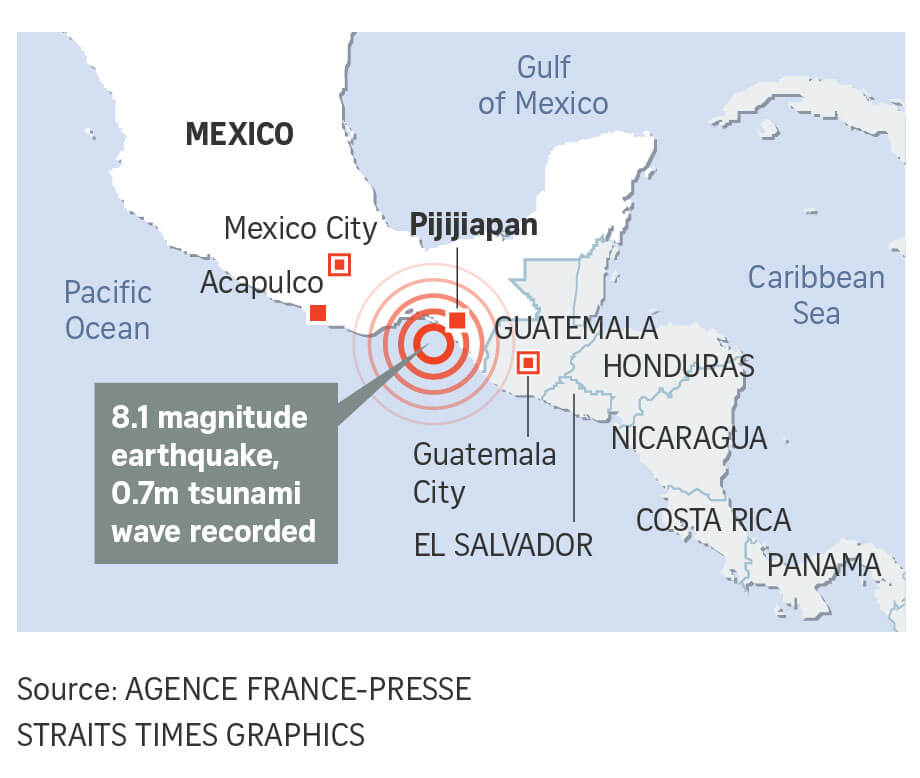Mexico’s strongest quake in 85 years kills dozens in the poor south
Sign up now: Get ST's newsletters delivered to your inbox
Follow topic:
JUCHITAN, MEXICO (REUTERS) - At least 61 people died when the most powerful earthquake to hit Mexico in over eight decades tore through buildings and forced mass evacuations in the poor southern states of Oaxaca and Chiapas, triggering alerts as far away as South-east Asia.
The 8.1 magnitude quake off the southern coast late on Thursday (Sept 7) was stronger than a devastating 1985 temblor that flattened swathes of Mexico City and killed thousands.
The tremor rattled Mexico City and shook Guatemala and El Salvador, but the Oaxacan town of Juchitan bore the brunt of the disaster, with sections of the town hall, a hotel, a church, a bar and other buildings reduced to rubble.
Dalia Vasquez, a 55-year old cook, said she watched emergency workers haul the bodies of her elderly neighbour and her middle-aged son from their collapsed home. Her own house was badly damaged. Frightened by the possibility of aftershocks, she planned to sleep with dozens more in the streets and parks.
"We have nothing now. We don't have any savings," she said.
President Enrique Pena Nieto flew to the battered town to oversee rescue efforts. The town's mayor, Gloria Sanchez, called it "the most terrible moment" in Juchitan's history.
Facades of shattered buildings, fallen tiles and broken glass from shop fronts and banks littered the pavements of Juchitan while heavily armed soldiers patrolled and stood guard at areas cordoned off due to the extent of the damage.
Startled residents stepped through the rubble of about 100 wrecked buildings, including houses, a flattened Volkswagen dealership and Juchitan's shattered town hall. Scores paced the terrain or sat outside warily, mindful of the frequent aftershocks and reliving the night's terror.
"It was brutal, brutal. It was like a monster, like a train was passing over our roofs," said Jesus Mendoza, 53, as he milled about in a park across from the damaged town hall.
Alma Rosa, sitting in vigil with a relative by the body of a loved one draped in a red shroud, said: "We went to buy a coffin, but there aren't any because there are so many bodies."

All the deaths were in three neighbouring states clustered near the epicentre that lay about 70 km off the coast.
At least 45 people died in Oaxaca, many of them in Juchitan, while in Chiapas the count reached 12 and in Tabasco four people lost their lives, according to federal and state officials.
In Chiapas, home to many of Mexico's indigenous ethnic groups, thousands of people in coastal areas were evacuated as a precaution when the quake sparked tsunami warnings, but only 0.7m waves were produced by the quake.
State oil company Pemex said there was no structural damage to its 330,000 barrel-per-day Salina Cruz refinery, which it had shut down as a precaution, but it said it was checking problems in the electrical system before restarting the plant.
WOKEN IN THE NIGHT
At least 250 people in Oaxaca were also injured, according to agriculture minister Jose Calzada. Classes were suspended in much of central and southern Mexico on Friday to allow the authorities to assess the impact. Dozens of schools were damaged, officials said.
People ran into the streets in Mexico City, one of the world's largest metropolises and home to more than 20 million, and alarms sounded after the quake struck just before midnight.
The US Geological Survey (USGS) said the quake's epicentre was 87km south-west of the town of Pijijiapan at a depth of 69km. John Bellini, a geophysicist at the USGS National Earthquake Information Centre in Golden, Colorado, said it was the strongest quake since an 8.1 temblor struck the western state of Jalisco in 1932.
Across the Pacific, both the Philippines and New Zealand were on alert for possible tsunamis.
OUTAGES, AFTERSHOCKS
Windows were shattered at Mexico City airport and power went out in several neighborhoods of the capital, affecting more than 1 million people. The cornice of a hotel came down in the southern tourist city of Oaxaca, a witness said.
Mexico City is built on a spongy, drained lake bed that amplifies earthquakes along the volcanic country's multiple seismic fault lines. The 1985 earthquake was just inland, about 370km from Mexico City, while Thursday's was 756km away.
The authorities reported dozens of aftershocks, and President Pena Nieto said the quake was felt by around 50 million of Mexico's roughly 120 million population.
Mexico is evaluating whether the quake will trigger a payout from a World Bank-backed catastrophe bond, Finance Minister Jose Antonio Meade said on Friday. Meade said the bond's coverage could reach US$150 million, depending on magnitude and location. But he said Mexico has sufficient funds to pay for a cleanup whether the bond was triggered or not.

